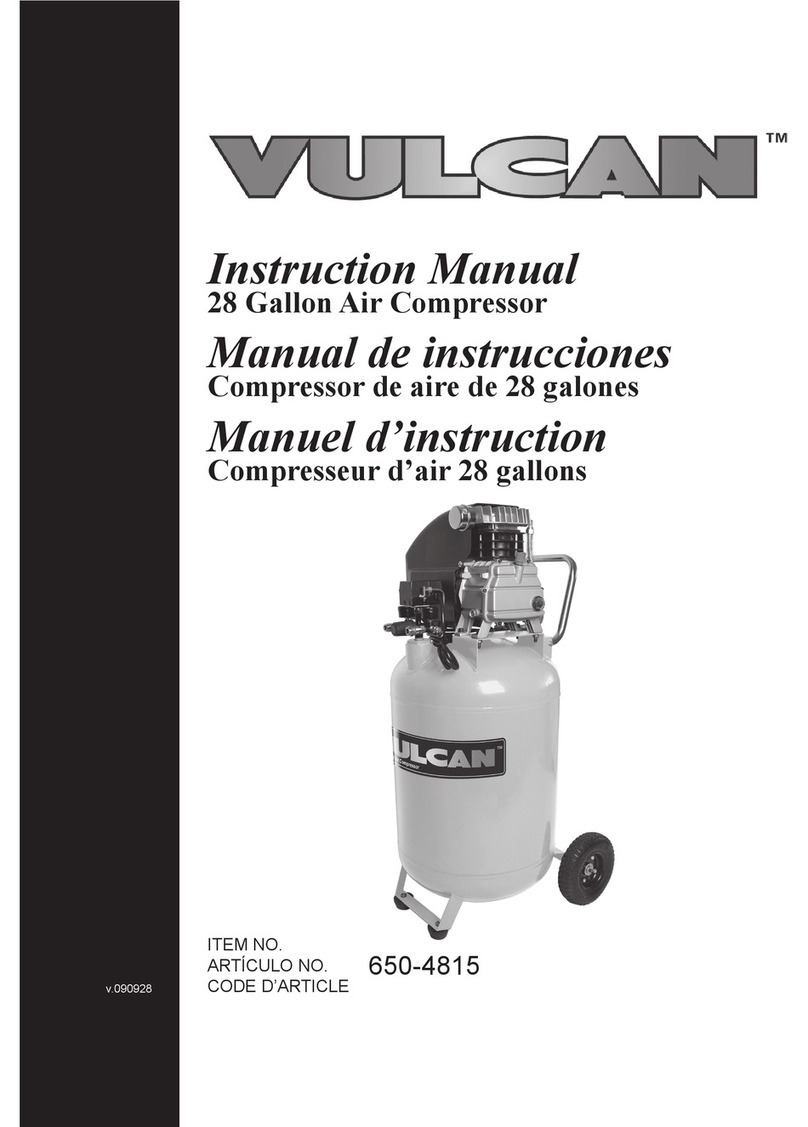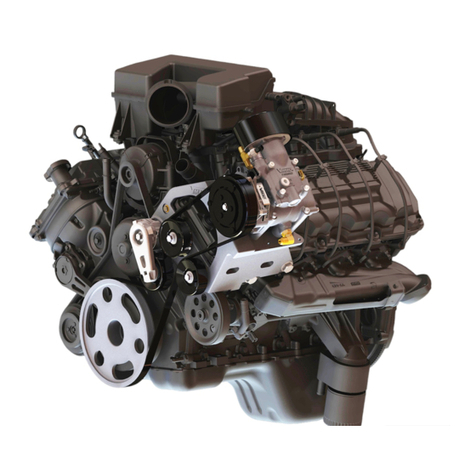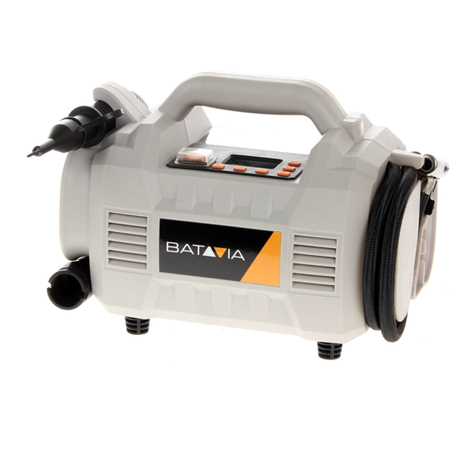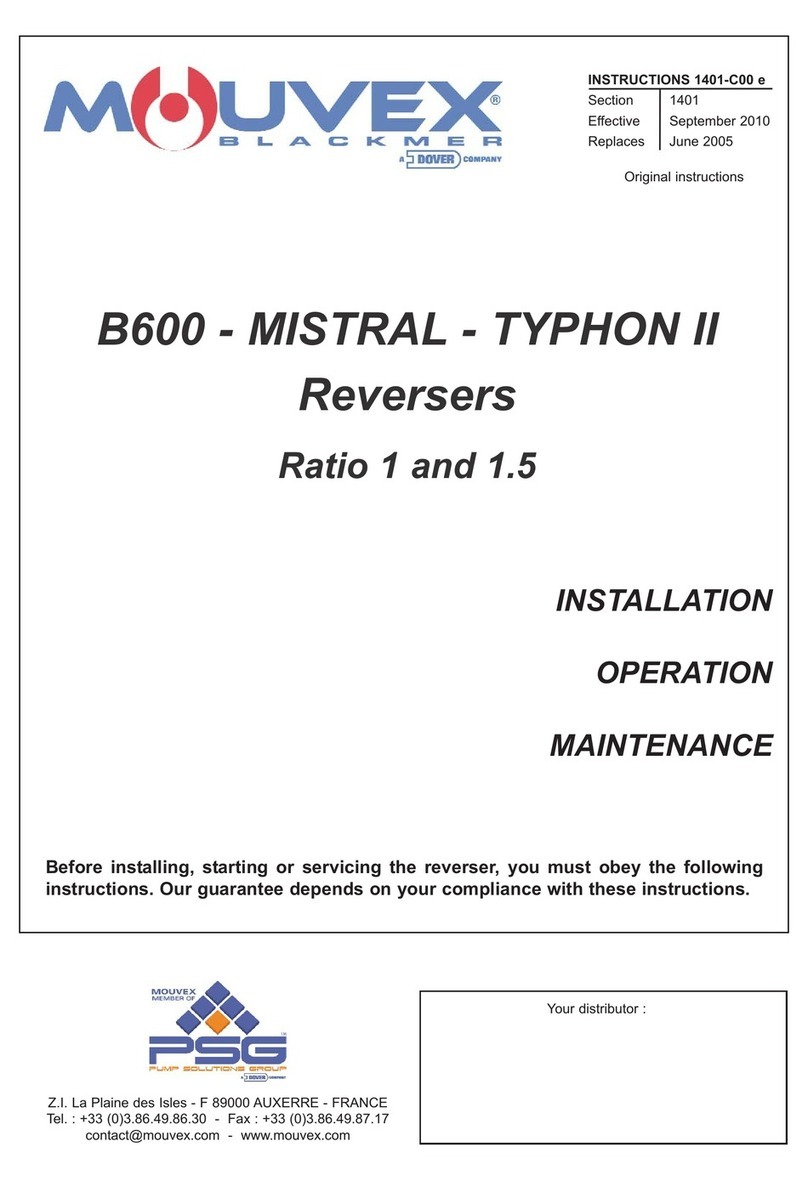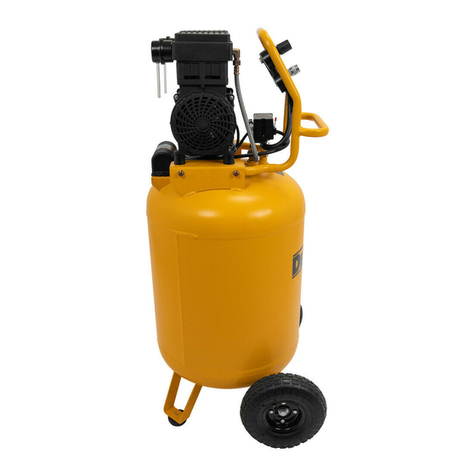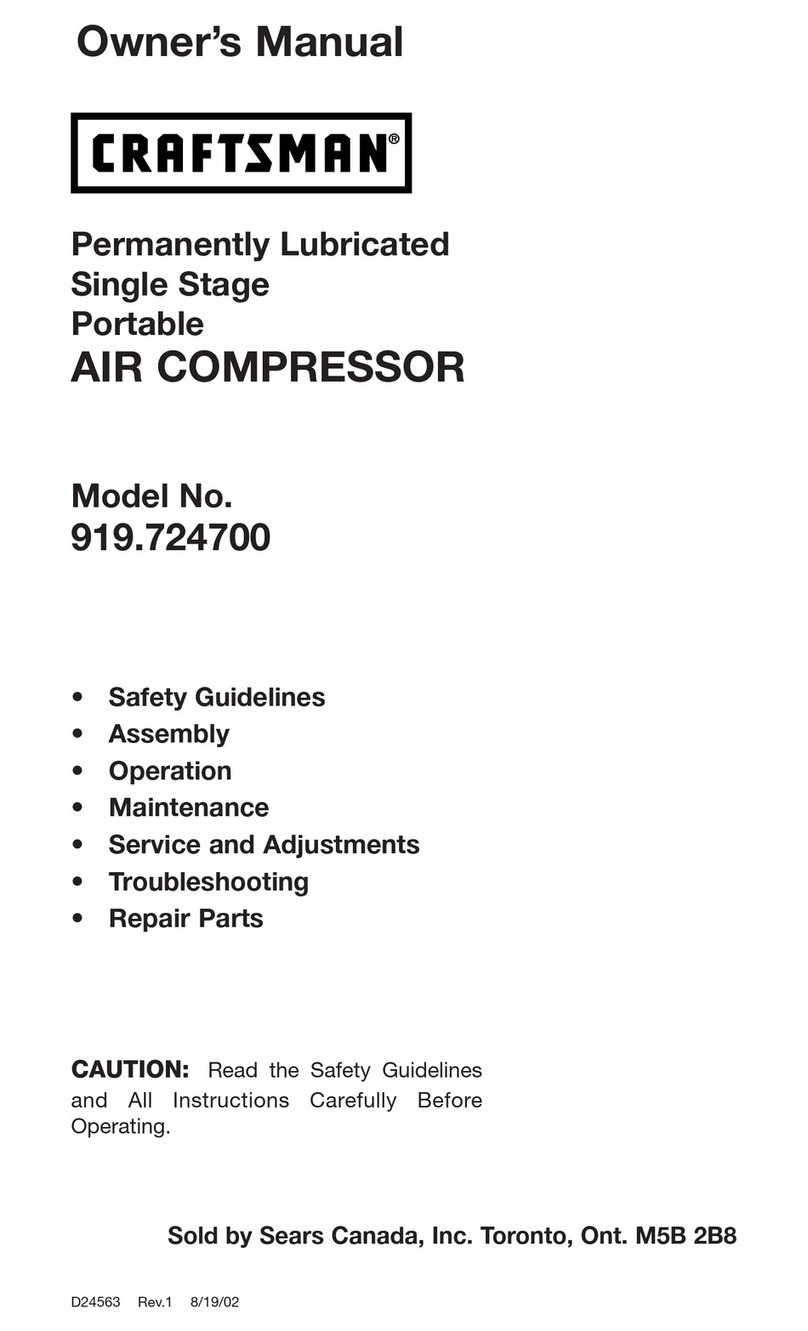Vulcan-Hart 176-6799 User manual

Instruction Manual
Manual de instrucciones
Manuel d’instruction
ITEM NO.
ARTÍCULO No.
176-6799
v080103
2.5 HP 8 Gallon Air Compressor
Compresseur d’air 8 gallons 2,5 HP

2
THANK YOU for your purchase of this Vulcan Air Tool. With proper care and
use you can expect your purchase to provide years of trouble free service!
SHOULD YOU HAVE A QUESTION OR A PROBLEM WITH YOUR
VULCAN TOOL, PLEASE CALL OUR CUSTOMER SERVICE
DEPARTMENT TOLL FREE AT:
1-800-482-0131
Please have the tool, model number and instruction manual at hand before calling.
ONE YEAR LIMITED CONSUMER WARRANTY
If you have a question or should you have a problem with any Vulcan Air Tool, call
the Vulcan Customer Service line at 1-800-482-0131.
This product is warranted to be free from defects to material and workmanship
for a period of ONE YEAR from date of purchase. If defective the product will be
repaired or replaced. Call the Vulcan Power Tool customer service line at 1-800-
482-0131 and a customer representative will attempt to help resolve any issue. If
directed by a representative, return the product along with proof of purchase to
your dealer. Normal wear, damage due to abuse or mishandling or unauthorized
repair is not covered. This warranty does not apply to accessories. This warranty
gives you specic legal rights that vary from state to state.
This tool is intended for consumer use and is not a commercial tool. In the event
the tool is used commercially, the warranty should be for a period of 30 days.
VULCAN AIR TOOLS ARE MADE EXCLUSIVELY FOR:
Memphis, TN 38101

3
Work Area
Keep work area clean. Cluttered areas invite
injuries.
Consider work area environment. Don’t use
power tools or equipment in damp, wet, or poorly
lit locations. Don’t expose your to rain. Keep the
work area well lit. Don’t use in the presence of
ammable gases or liquids.
Keep children and bystanders away. All
children should be kept away from the work
area. Don’t let them handle machines, tools or
extension cords. Visitors can be a distraction and
are difcult to protect from injury.
Electrical Safety
Grounded tools must be plugged into an outlet
that itself is properly installed and grounded.
Grounding provides a low-resistance path to
carry electricity to the ground and away from the
operator, should the tool malfunction electrically.
Do not remove the grounding prong from the
plug or alter the plug in any way. If in doubt as to
whether the outlet is properly grounded according
to code, check with a qualied electrician.
Observe proper precautions regarding double
insulation. This unit is double insulated. It is
equipped with a polarized plug. One blade is
wider than the other, so it will t into a polarized
SAFETY RULES FOR ALL TOOLS
Read and understand all instructions. Failure to follow all instructions listed
below may result in serious personal injury.
SAVE THESE INSTRUCTIONS
When using electric tools, machines or equipment, basic safety precautions should
always be followed to reduce the risk of re, electric shock, and personal injury.
WARNING
!
outlet only one way. If you have difculty
inserting the plug, try reversing it. If it still
doesn’t t, do not alter the plug; have a qualied
electrician install a polarized outlet.
Guard against electric shock. Prevent body
contact with grounded surfaces: pipes, radiators,
ranges, and refrigerator enclosures. When your
body is grounded the risk of electric shock
increases. When working wherever “live”
electrical wires may be encountered, try to
ascertain whether there is a danger of shock.
Even so, DO NOT TOUCH ANY METAL PARTS
OF THE TOOL while using it. Hold the tool only
by the plastic grip to prevent electric shock if you
contact a live wire.
Do not abuse the cord. Never carry your
power equipment by the cord or pull on the cord
to unplug it. Protect the cord from potential
sources of damage: heat, oil & solvents, sharp
edges, or moving parts. Replace damaged cords
immediately.
When working outdoors, use an outdoor-rated
extension cord. An extension cord rated for
outdoor use must be marked “w-a” or “w”.
Do not expose electrical power tools to
moisture. Rain or wet conditions can cause water
to enter the tool and lead to electric shock.
Recommended Minimum Wire Gauge for Extension Cords
Amps 25’ long 50’ long 75’ long 100’ long 150’ long 200’ long
0 - 5 16 ga. 16 ga. 16 ga. 14 ga. 12 ga. 12 ga.
5.1 - 8 16 ga. 16 ga. 14 ga. 12 ga. 10 ga. Do Not Use
8.1 - 12 14 ga. 14 ga. 12 ga. 10 ga. Do Not Use Do Not Use
12.1 - 15 12 ga. 12 ga. 10 ga. 10 ga. Do Not Use Do Not Use
15.1 - 20 10 ga. 10 ga. 10 ga. Do Not Use Do Not Use Do Not Use
WARNING
!

4
Ensure the extension cord you use is of
sufcient gauge for its length.
Personal Safety
Dress properly. Don’t wear loose clothing or
jewelry; they can be caught in moving parts.
Protective, non-electrically conductive gloves
and non-skid footwear are recommended when
working. Wear protective hair covering to contain
long hair and keep it from harm.
Use eye protection. Use a full-face mask if the
work you’re doing produces metal lings, dust
or wood chips. Goggles are acceptable in other
situations. Wear a clean dust mask if the work
involves creating a lot of ne or coarse dust.
Don’t overreach. Keep proper footing and
balance at all times. Do not reach over or across
machines that are running.
Stay alert. Watch what you are doing & use
common sense. Don’t operate any tool when you
are tired.
Compressed air cautions: compressed air from
this unit may contain carbon monoxide. The air
produced is neither suitable for breathing nor
food processing without ltering and testing to all
applicable legal standards.
Breathing protection: always use a respirator
when spraying paint or chemicals.
Tool Use and Care
Maintain tools with care. Keep tools sharp and
clean for better and safer performance. Follow
instructions for lubricating and safe performance.
Follow instructions for lubricating and changing
accessories. Keep handles dry, clean and free
from oil and grease.
Avoid unintentional starting. Be sure the
switch is in the off position before plugging in.
Always check and make sure to remove any
adjusting keys or wrenches before turning the
tool on. Left attached, these parts can y off a
rotating part and result in personal injury.
Do not use the tool if it cannot be switched on
or off. Have your tool repaired before using it.
Disconnnect the plug from power before
making any adjustments. Changing attachments
or accessories can be dangerous if the tool could
accidentally start.
Store idle equipment. Store equipment in a dry
area to inhibit rust. Equipment also should be in
a high location or locked up to keep out of reach
of children.
Don’t force the tool. It will do the job better and
more safely at the rate for which it was intended.
Use the right tool. Don’t force a small tool or
attachment to do the work of a larger industrial
tool. Don’t use a tool for a purpose for which it
was not intended.
Secure work. Use clamps or a vise to hold the
work. It’s safer than using your hands and it frees
both hands to operate the tool.
Check for damaged parts. Before using this
tool, any part that is damaged should be carefully
checked to determine that it will operate properly
and perform its intended function. Check for
alignment of moving parts, binding of moving
parts, breakage of parts, mountings, and other
conditions that may affect its operation. Inspect
screws and tighten any ones that are loose. Any
part that is damaged should be properly repaired
or replaced by an authorized service center unless
otherwise indicated elsewhere in the instruction
manual. Have defective switches replaced by an
authorized service center. Don’t use the tool if
switch does not turn it on and off properly.
Never use this equipment if it is leaking air; has
missing or damaged parts, guards, or shields; or
requires repair. Make sure all screws and caps are
securely tightened.
Do not use the air hose to move the compressor.
Release the pressure in the storage tank before
moving.
Maintain tools with care. Keep tools clean for
better and safer performance. Follow instructions
for lubricating and changing accessories. Keep
dry, clean and free from oil and grease.
Do not attempt any maintenance or adjustment
with the compressor in operation, the power
connected, or air under pressure in the system.

5
Service
Check for damaged parts. Make frequent
inspections for the correct function of components
and safety mechanism.
Replacement parts. When servicing, use
only identical replacement parts and fasteners
recommended by us.
Service and repairs should be made by qualied
repair technicians at an authorized repair centre.
Improperly repaired tools could cause serious
shock or injury.
Employers must enforce compliance with the
safety warnings and all other instructions in this
manual. Keep it available for use by everyone
assigned to use this equipment.
Safety precautions for compressor components
Air only: use this compressor for compressing air
only. Do not compress other gases.
Tank safety valve: this valve prevents damage to
the air receiver if a malfunction in the compressor
pump occurs. It is factory pre-set at a limit
specic to your particular model and adjustment.
Do not tamper with it. This will automatically
void your warranty.
Pressure switch: the air pressure switch is factory
pre-set for optimum performance. Do not bypass
or remove this switch. Serious damage to
equipment or personal injury could result from
too high an air pressure.
Motor and compressor pump: air compressors
get hot during operation. Do not touch the
motor, discharge tubing, or compressor while
it is running. The compressor turns itself on
automatically while the power is connected.
Air tanks: over-pressurizing the air receivers,
piping or tanks could cause it to explode or burst.
To protect from over-pressurizing, the compressor
is equipped with a factory preset safety valve. Do
not remove, make adjustments to or substitutions
for this valve. Perform a test of the valve from
time to time: pull the ring on the valve to make
sure that it operates freely. If the valve does not
operate freely, replace it before further use. Never
weld to, drill into, or change the air receivers in
any way.
Tampering: if any of the components above are
found to have been changed or tampered with, the
warranty will be made void. When servicing, we
recommend using only identical replacement parts
and any replacement parts used must have the
same specication as the original equipment.
The warnings, cautions, and instructions detailed in this manual cannot
cover all possible conditions and situations that occur. It must be understood
by the operator that COMMON SENSE AND CAUTION ARE FACTORS
that cannot be built into this product, but MUST BE SUPPLIED BY THE
OPERATOR.
WARNING
!

6
Nomenclature for No. 176-6799 2.5 HP Air Compressor

7
Nomenclature for No. 176-6799 2.5 HP Air Compressor
KEY
ARubber-tired wheel
BFixed 4 gallon air tank
CInput hose for portable tank
DInput shut-off valve for portable tank
ECompressor on/off switch
FLifting handle
GRemoveable 4 gallon portable air tank
HRubber hold-down strap for portable
tank
IFold-out rolling transport handle
JQuick change coupler
KPortable tank pressure gauge
LPortable tank carry handle
MTire chuck output tting for portable
tank
NTool tray
ORegulated output pressure gauge
POil ll plug/breather cap
QRegulator knob
RQuick-connect air couplers
STank pressure gauge
TAir lter / mufer
UPortable tank cradle bracket
VOil level sight gauge
WReset button
SPECIFICATIONS
l2.5 HP – 8 gallon
2 x 4 gal. stacked tanks
lOil lubricated for durability and
long life
lExtremely quiet operation
lRubber grip rolling handle
lIncludes air line regulator & 2 gauges-
allows setting exact line pressure
lOil ll plug/breather cap (may require
attachment to compressor)
l2 Quick-connect air line ttings
lTough powder coated nish
lRemoveable and portable air tank with
separate gauge & tire ll hose
l120 volt, 60 Hz, 14.4 Amp
l1,750 rpm
l4.1 cfm @ 90 psi, 5.2 cfm @ 40 psi
lMaximum pressure: 150 psi
lWeight: 80.5 lbs
lPackage weight: 84.9 lbs

8
FUNCTIONAL DESCRIPTION
Your new air compressor can be used for operating paint, weed killer, and insecticide
sprayers, air tools, grease & caulking guns, sandblasters, ination, etc. A tool with a higher air
demand than this compressor can produce may either not function, or not function well. It may
also cause the compressor to run without stopping for long periods of time, trying to maintain
pressure in the tank. This can cause either the motor or compressor pump to overheat and
damage them. Be sure the requirements of your tools can be met by the compressor.
To compress air, the piston in the pump moves up and down in the cylinder. On the down
stroke, air is drawn in through the inlet valve. Since the discharge valve remains closed, as the
piston goes up, the air in the cylinder is compressed. The inlet valve closes and compressed
air is forced out into the air receiver. A check valve prevents it from going back into the pump.
Working air is not immediately available. The pump continues to add air until the air receiver
pressure builds to above that required at the regulator.
SET-UP
After removing it from the carton, and before you can use your compressor, you must perform
some work preparatory to using your compressor:
You will need:
l at blade screwdriver
l 8 .oz. SAE-20 or SAE-10 non-detergent compressor oil
l Pipe thread sealant tape
OIL
WARNING
!
This compressor requires oil of the correct type and quantity to run. Do not
start it without rst following all the steps in this
section.
1. Be sure the compressor is on a level surface.
2. With the screwdriver, pry off and remove the shipping
plug from the top of the crankcase (g.3) revealing the
oil ll hole.
3. Through this hole, ll the oil reservoir with SAE-20
(API CG/CD heavy duty), non-detergent compressor
oil. In extreme winter conditions, use lighter SAE-10
weight.
4. The reservoir capacity is approximately 8 .oz. There
may be some oil left over from the manufacturing
process already in the reservoir. Be careful not to
overll.
5. Check the oil level sight glass (V in g.2 & 4). The oil
should show level with the red dot in the centre of the
viewing window.
6. Find the oil ll plug/breather cap (P in g.1, 2 & 4). It is
usually shipped separately from the compressor and
enclosed with this manual. Be sure there is a rubber
O-ring on the threaded end.
7. Put a little pipe thread sealing tape on the threaded
end of the oil ll plug/breather cap.

9
8. Gently screw the oil breather cap into the oil ll hole. Do not cross-thread or overtighten.
NOTE Before installing and using this unit, inspect carefully for damage and corrosion. Make
sure the tank, compressor, motor and pump are undamaged and that all screws and caps
are securely tightened.
INSTALLATION AND LOCATION
Locate the compressor in a clean, dry and well-ventilated area; on a rm, level surface. It
should be located 12 to 18 inches from a wall or any other obstruction that would interfere with
the air ow. It is equiped with heat dissipation ns that allow for proper cooling. Keep them and
other parts free of dust or dirt that could interfere with cooling. A clean compressor runs cooler
and provides longer service. Do not place anything on top of the compressor.
WARNING
!
Do not use lead-tin solder to join pipes and ttings. It can melt at the
temperatures of the compressor’s air discharge and cause the piping to burst.
ELECTRICAL REQUIREMENTS
l Check the specication label and be sure the
compressor’s voltage and amperage requirements
match the electrical supply capabilities.
l Plug your compressor into an electrical outlet on
dedicated 15 amp household circuit. The closer the
outlet is to the circuit panel, the more reliable the
compressor starting and performance will be. Other
devices running on the same circuit may cause
starting problems.
l Slow starting may cause the compressor’s internal
overload protection to trip. Press the compressor’s
reset button (W, g.2 & 5) to allow it to restart.
l Ideally, the electrical supply circuit should be protected
by a circuit breaker rather than a fuse. If a fuse is
necessary, a dual element time delay fuse should be
used.
EXTENSION CORDS
If you plan to use an extension cord when operating your
air compressor, please note:
l Maximum length: not to exceed 50 ft.
l Minimum wire size: 14 gauge.
l If the extension cord is too long or the wire size is too
small, the air compressor will not start.
COMPRESSOR LUBRICATION
1. CHECK THE OIL quantity and quality every time before operating the compressor. Do
not add or change oil while the compressor is in operation. Use only oil with the correct
specications

10
2. With the air compressor on level surface, the oil level should be at the red dot on the oil
level sight glass.
3. If oil level is low, remove oil ll plug/breather cap, add enough oil to bring level to the red
dot. Do not over-ll.
4. Replace oil ll plug/breather cap before starting compressor.
DRAINING THE OIL
1. Remove the oil drain plug (oil level sight glass). Allow oil to drain completely.
2. Replace the oil drain plug (we recommend the use of a sealing compound or teon tape
to avoid leakage). Do not over-tighten.
3. Rell with the recommended oil to the red dot in the oil level sight glass.
OPERATION
BEFORE OPERATING:
1. Check that all nuts and bolts are all snug.
2. Check the quantity and quality of oil (see compressor lubrication, above).
INITIAL BREAK-IN
1. Open (turn the knurled brass knob out, counter-clockwise) the Moisture release petcock
(Z, g.6) on the bottom of the lower air tank to permit
air to escape, so no air pressure builds up in the air
tank.
2. Plug power supply cord into correct power source.
3. Pull up on the On/Off switch lever (E, g.1 & 7) to
start the compressor.
4. Run the compressor in this no-load condition for 15
to 20 minutes to lubricate the bearings and pistons.
5. Close (turn the knurled knob in, clockwise) the air
tank Moisture release petcock.
6. Pressure will build in the tank and the Pressure switch will stop the pump when it reaches
the pressure set on the regulator. Your compressor is now ready for use.
NOTE During the break-in period, there may be a slight smell as the electrical motor brushes
seat themselves. This may last for about 5 minutes and is normal.
CAUTION
!
If the compressor does not run properly after 15 minutes of the break-in or if
you notice any abnormalities, please contact the service center.
NOTE If the Pressure switch fails to shut off the compressor for any reason, each of the
tanks has a safety valve (pictured at X, g.6 on the lower tank; and at Y, g.8 on the
portable) which will open automaically when pressure in that tank becomes too great.
PORTABLE TANK REMOVAL / INSTALLATION
WARNING
!
Before removing or installing the portable air tank, be sure to disconnect air
compressor unit from power source.

11
Removing the Portable Air Tank:
1. Move the Compressor on/off switch (E, g.1 & 7) to
the off (down) position.
2. Lift the Fold-out rolling transport handle up (I, g.1 &
2) and away from the portable air tank.
3. Close the Input shut-off valve for portable tank (D,
g.1 & 7) by turning it so the arm points across the
direction of the airow.
4. Disconnect the hose from the quick connect coupler
(J,g.1 & 8).
5. Loosen the Rubber hold-down straps for portable
tank (H, g.1 & 2) to release the air tank.
The tank has now been properly disconnected from the
air compressor unit. You can now move the tank
freely.
Installing the Air Tank:
1. Move the Compressor on/off switch (E, g.1 & 7) to
the off (down) position.
2. Place the portable air tank in the appropriate
position, resting on the two Portable tank cradle
brackets (U, g.2).
3. Fix the air tank to the compressor unit using the Rubber hold-down straps for portable
tank (H, g.1 & 2).
4. Reconnect the hose with the quick connect coupler (J, g.1 & 8).
5. Open the Input shut-off valve for portable tank (D, g.1 & 7) by turning it so the arm points
in the direction of the airow.
The portable air tank has been properly installed and connected to the air compressor unit.
Your air compressor is now ready for use.
OPERATION
1. Be sure the On/Off switch (E, g.1 & 7) is swung down & in the Off position.
2. Close (turn the knurled knob in, clockwise) the air tank Moisture release
petcock (Z, g.6).
3. Plug in the power cord.
4. Pull up on the On/Off switch to turn the unit on.
5. Adjust the Regulator (R, g.1 & 2) so that the needle on the Regulated output pressure
gauge (O, g.1 & 2) is set to the working pressure of the air tool you plan to use.
6. Connect the air tool to an air hose.
7. Connect the air hose to the compressor by inserting its quick-connector plug into one of
the two quick-connect air couplers (Q, g.1 & 2) on the compressor panel. Be sure the
connectors are properly connected.

12
8. Follow all instructions for the use of the air tool.
9. As air is used by the tool, the compressor will start up automatically to replenish the
pressure in the tanks and stop when full. It will continue to cycle as you work.
WARNING
!
The compressor motor and pump can get quite hot in operation. Do not touch
or allow others near the unit during or after operation.
10. When nished, disconnect the air hose by pushing the quick-connect plug in slightly while
sliding the sleeve on the coupler back to release the plug.
11. Push in the On/Off switch to stop the compressor.
12. Open the moisture release petcock (M, g.1) and allow all the air to escape from the
tanks.
WARNING
!
Wear safety goggles when opening the petcock. The escaping air can raise
debris particles which can damage your eyes.
l After 2 weeks, tighten all nuts and bolts, including head bolts.
MAINTENANCE
WARNING
!
Before any maintenance or adjustments to your air compressor, always take
the following safety precautions:
1. Disconnect electrical power.
2. Open the petcock to drain air tank of pressure.
DAILY MAINTENANCE
Before each use:
l Check the oil level
l Be sure all nuts and bolts are tight
l Check for any unusual noise or vibration
l After use: open the air tank drain cock to drain condensation from tank. This is especially
critical in cold conditions when condensation could freeze in the tank and cause
mechanical damage as well as rust.
MONTHLY MAINTENANCE
l Inspect air system for leaks by applying soapy water to all joints.
l Tighten those joints if leakage is observed.
l Check that all nuts and bolts stay tight.
250 HOURS or 6 MONTHS (whichever comes rst): OIL CHANGE
l After 250 hours of use, your compressor will require an oil change.
l Paint spraying operations or dusty environments may require you replace oil more often
WARNING
!
Before any removing the oil drain plug (oil level sight glass) or the oil breather
cap from your air compressor, always take the following safety precautions:
l Disconnect electrical power.
l Open the petcock to drain air tank of pressure.

13
1. Remove the oil drain plug (oil level sight glass). Allow oil to drain completely.
2. Replace the oil drain plug (we recommend the use of a sealing compound or tape to
avoid leakage). Do not over-tighten.
3. Rell with the reservoir with SAE-20 (API CG/CD heavy duty), non-detergent compressor
oil or for extreme winter conditions use SAE-10 weight
4. The reservoir capacity is approximately 235 ml (8 .oz). Fill to the red dot in the oil level
sight glass. Do not over-ll.
CAUTION
!
l All air line components (including hoses, pipe, connectors, lters, & regulators, etc.) must
be rated for a minimum working pressure of 150 psi or 150% of the maximum system
pressure, whichever is greater.
l Disconnect any tools from the air supply before performing maintenance, clearing a
jammed fastener, leaving the work area, moving the tool to another location, or handing it
to another person.
l When cleaning air lter, or any parts in direct contact with the air production, do not use
any ammable or toxic cleaner or solvent.
l During the break-in period, nuts and bolts have a tendency to loosen up. After two weeks,
tighten all nuts and bolts including head bolts.
GENERAL MAINTENANCE
l Keep the vents and cooling vanes clear of dust and debris. This will help prevent possible
electrical shorts and ensure proper cooling.
l Inspect the cord regularly and have it replaced by an authorized repair facility if it is
damaged.
l Check the tanks regularly for dents, cracks, rust, and other damage. Do not use if any
part of the pressurized system is damaged.
l An authorized repair center should do any repairs, modication, or maintenance that
involve disassembling the compressor.
l Please call toll-free 1-800-482-0131 with any questions you have or service advice you
may need.

14
SYMPTOM POSSIBLE CAUSE REMEDY
Compressor runs
continuously Petcock is open Close petcock
Prolonged or excessive use
of air Decrease air demand
Compressor is not large
enough for job Check the air requirement of
air tool.
Restricted check valve Remove and clean, or
replace
Leak in air hose or connector Check and replace if
necessary
Tank leaks Replace tank immediately!
Do not attempt to repair!
Blown seals Replace
Compressor starts and stops
excessively when not in use Petcock is partially open Close petcock
Fittings leak Check ttings with soapy
water. Tighten or re-seal
ttings. Do not over-tighten
Compressor will not start Fuse or circuit breaker tripped Check for cause & replace
or reset
Loose electrical connections Check wiring connections
Extension cord not correct Max. 50 ft. min. 14 ga.
Low voltage Consult electrician
Overheated motor Use reset button or wait for
auto reset
Check valve is stuck open Remove and clean or
replace
Pressure bleeder valve on
pressure switch has not
unloaded head pressure
Move switch to Off and then
restart
Paint spray on internal motor
parts Consult service centre
TROUBLESHOOTING
CAUTION
!
STOP using the tool immediately if any of the following problems occur.
Serious personal injury could occur. Any repairs or replacements must be done by a
qualied person or an authorized service center only.

15
SYMPTOM POSSIBLE CAUSE REMEDY
Circuit breaker trips (or fuse
blows) too often Low voltage Consult electrician
Excessive wire length Try to run compressor
without extension cord
Restricted air passages Contact service centre
Back pressure in pump head Replace check valve
Replace pressure switch
bleeder valve
Low pressure Air leak in safety relief valve Check valve manually: pull
ring outward
Restricted air lter Clean or replace air lter
Defective check valve Replace check valve
Safety pressure relief valve
opens Defective pressure switch or
improper adjustment Check for proper adjustment
and if problem persists,
replace pressure switch
Oil discharge in air Improper oil viscosity Replace with SAE-20 non-
detergent compressor oil
Too much oil in crankcase Drain crankcase and ll to
correct level
Compressor overheated Air pressure regulated too
high Reduce regulator setting
Restricted air lter Clean and replace air lter
Poor ventilation Relocate compressor
Dirty cooling surface Clean pump cooling vanes
Other Contact technical support
department: 1-800-482-0131
TROUBLESHOOTING
WARNING
!
l Repairs should be made by an authorized repair centre.
l Opening this tool could invalidate your warranty.

16
ITEM No. DESCRIPTION
1Head bolt
2 Spring washer
3Air lter
4Cylinder head
5Washer
6Exhaust elbow
7Gasket
8 Valve plate
9Gasket
10 Compression ring
11 Cylinder
12 Piston
13 Oil breather cap
14 Head bolt
15 Spring washer
16 Head bolt
17 Oil sight glass
18 O-ring
19 Crankcase cover
20 Connecting rod
21 Head bolt
22 Crank shaft
23 Gasket
24 Washer
25 Nut
26 Capacitor
27 Rotor
28 Bearing
29 Stator
30 Support bracket
ITEM No. DESCRIPTION
31 Spring washer
32 Head bolt
33 Fan
34 Cover
35 Washer
36 Head bolt
37 Shaft seal
38 Bearing
39 Rubber input hose
40 Pressure gauge
41 Combination valve
42 Portable tank
43 Head bolt
44 Spring washer
45 Washer
46 Rolling transport handle
47 Head bolt
48 Tray
49 Regulator
50 Pressure gauge
51 Air quick coupler
52 Rubber bushing
53 Panel
54 Nut
55 Head bolt
56 Nut
57 Head bolt
58 Wheel
59 Exhaust pipe
60 Fixed tank & chassis assembly
PARTS LIST
Please refer to the Schematic Drawing on page 51.

17
ITEM No. DESCRIPTION
61 Rubber foot
62 Head bolt
63 Exhaust pipe
64 Rubber output hose
65 Elbow joint
66 Pressure switch
67 Exhaust pipe
68 Nut
69 Washer
70 Head bolt
ITEM No. DESCRIPTION
71 Rubber strap
72 Moisture relief petcock
73 Safety valve
74 Unloader tube
75 Valve assembly
76 Valve plate spacer
77 Piston ring
78 Piston ring set
79 Circlips
80 Head bolt
PARTS LIST
Please refer to the Schematic Drawing on page 51.

18

19

20
Table of contents
Languages:
Other Vulcan-Hart Air Compressor manuals
Popular Air Compressor manuals by other brands
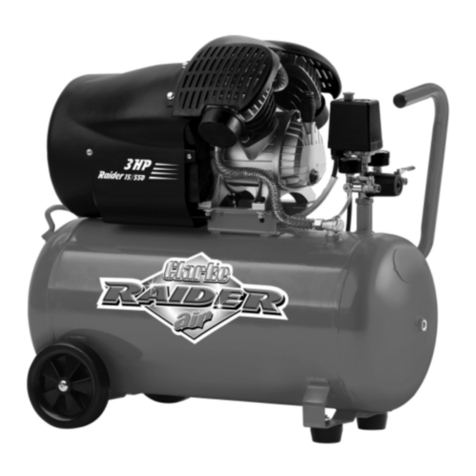
Clarke
Clarke RAIDER 15/550 Operation & maintenance instructions

Parkside
Parkside PKZ 180 B2 Translation of the original instructions
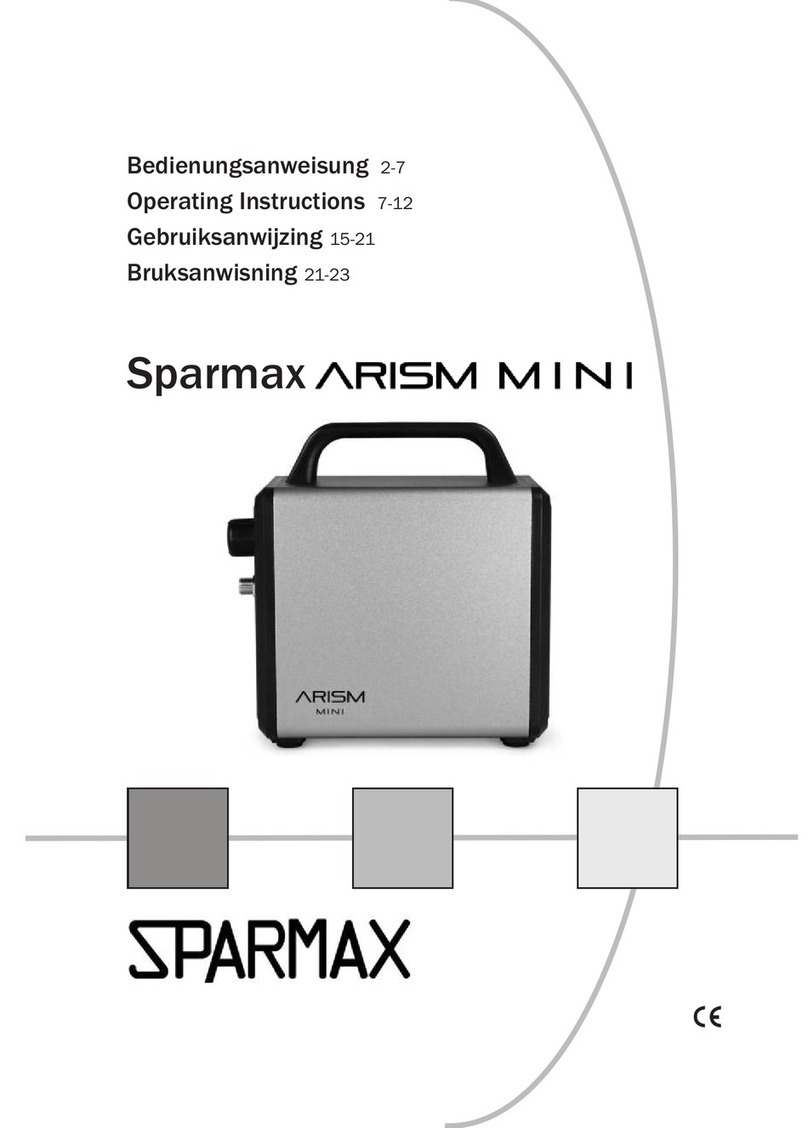
Sparmax
Sparmax DH-102 operating instructions
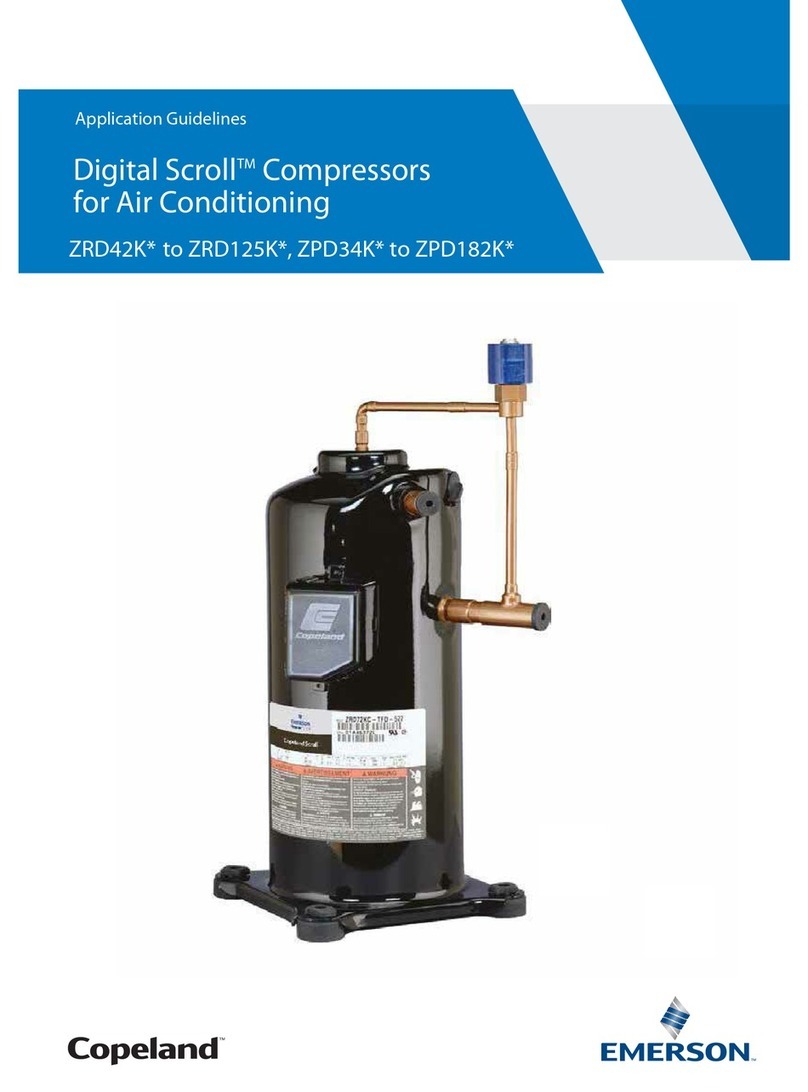
Copeland
Copeland Digital Scroll ZRD42KCE Guidelines
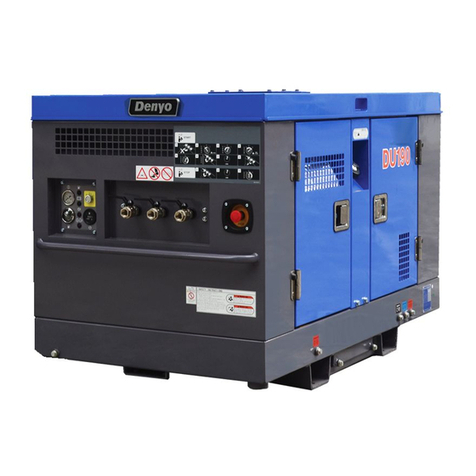
Denyo
Denyo DU-190 instruction manual

Gardner Denver
Gardner Denver ELECTRA-SAVER ESMF Operating and service manual
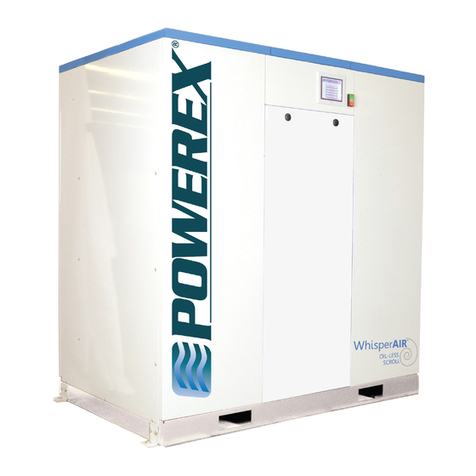
Powerex
Powerex SE Series operating & maintenance manual

DHP
DHP 1 Horsepower owner's manual
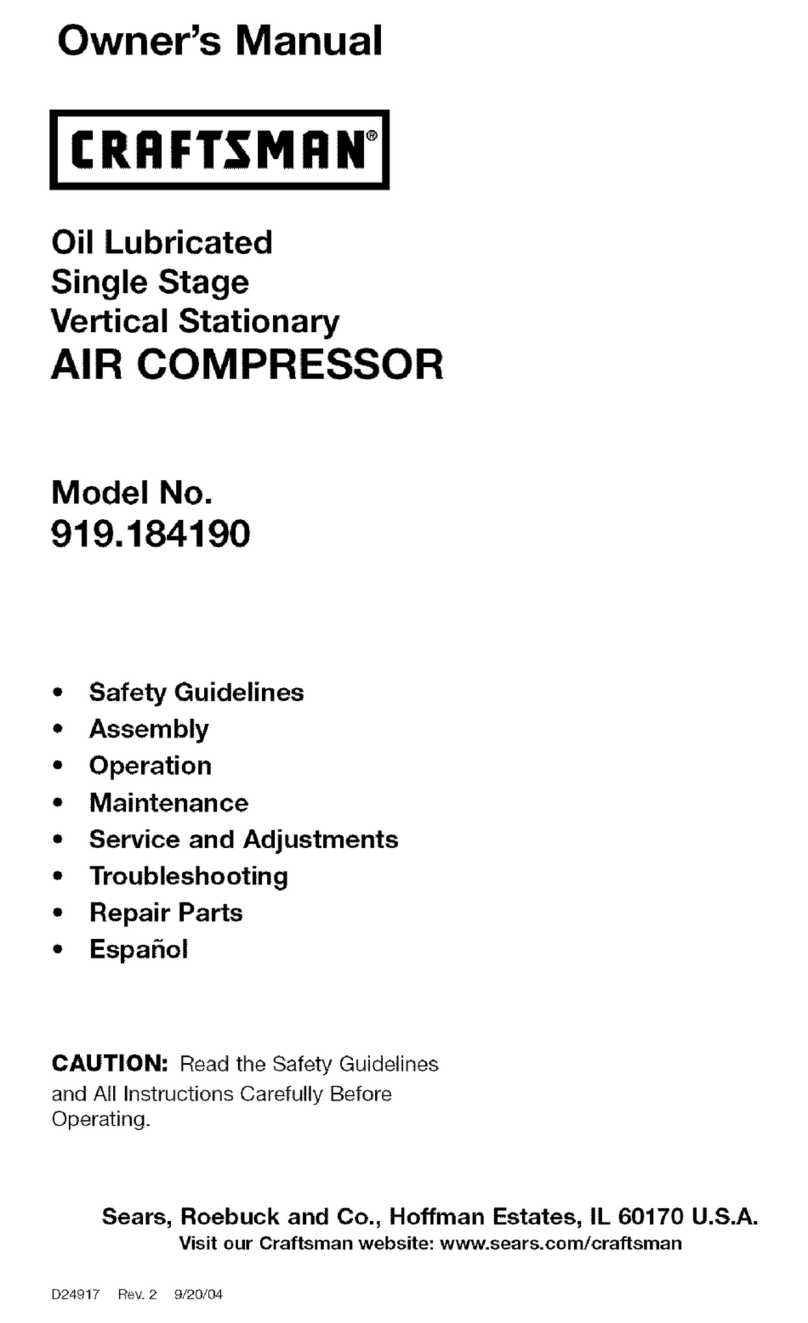
Craftsman
Craftsman 919.184190 owner's manual
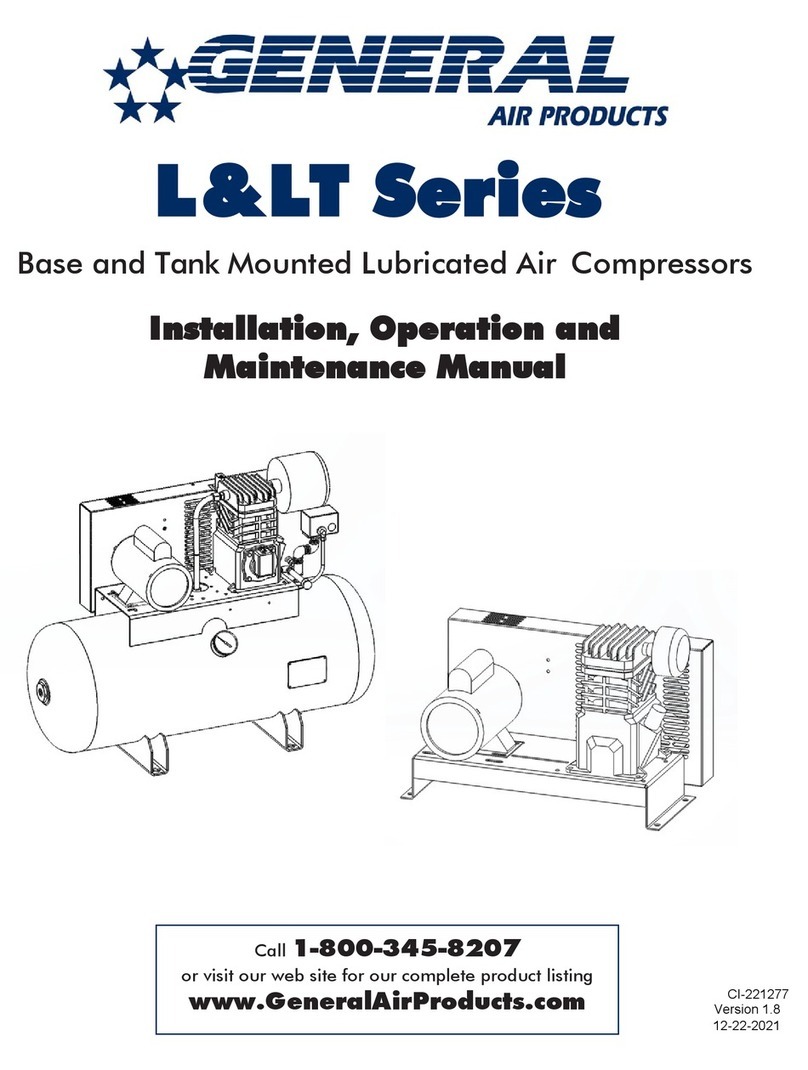
General Air Products
General Air Products L Series Installation, operation and maintenance manual
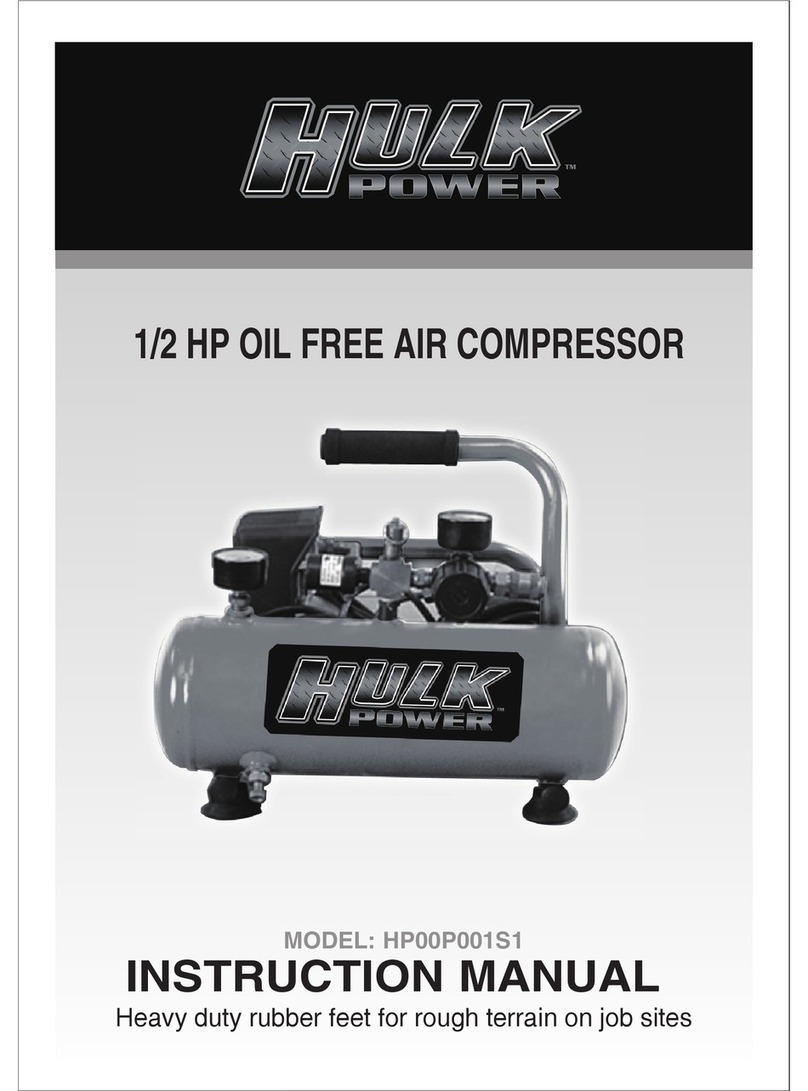
Hulk
Hulk HP00P001S1 instruction manual

Porter-Cable
Porter-Cable PXCM301 instruction manual
